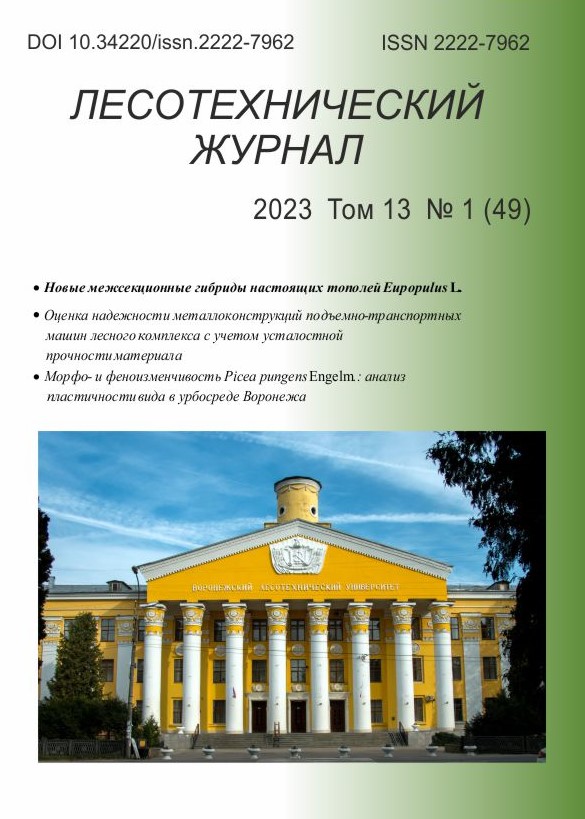630
68.47
When form protective forest stands along linear infrastructure facilities, the problem of subsequent spontaneous reproduction of trees and shrubs arises, littering the territories of the above facilities and creating a threat to the safety of their operation. Works on cleaning the territories of infrastructure facilities from unwanted tree and shrub vegetation are often organized without a sufficiently clear idea of the characteristics of the said vegetation to be removed, which negatively affects the quality of the performance of these works.The purpose of the research is to determine the species composition of undesirable plant communities that form on the territories of linear infrastructure facilities in order to increase the efficiency of their removal and draw up recommendations for the proper maintenance of these territories. It was revealed that most types of undesirable vegetation growing on the territories of linear infrastructure facilities in the Central part of Russia belong to Magnoliophyta (flowering, about 97 %) and Pinophyta (gymnosperms, about 3 %).It was revealed that most types of undesirable vegetation growing on the territories of linear infrastructure facilities in the Central part of Russia belong to Magnoliophyta (flowering, about 97 %) and Pinophyta (gymnosperms, about 3 %). About 54 % of the protection zones of power lines and right of way of roads, as well as about 33 % of the right of way of railways in the Central part of Russia have a similar species composition of unwanted vegetation, however, the maximum similarity is not ensured by the location of sections of infrastructure facilities in close proximity to each other. For the protection zones of power lines, it is possible to determine the species composition of growing undesirable vegetation in one of these areas, followed by dissemination of the results of the study to another nearby area. For railroad right of way, such dissemination of the study results is inappropriate. In fact, on each of the sections of the right of way of roads and railways, as well as the routes of power transmission lines in Central Russia, such types of unwanted vegetation grow as ash-leaved maple (Acer negundo L., with a share of participation in the studied plant communities from 6.3 % to 98.1 %) and smooth elm (Ulmus laevis Pall, with a share of 1.1 % to 41.1 %). Among the types of unwanted trees and shrubs most expected to grow in these territories, about 36 % are prone to their renewal by stump growth, about 42 % – by root offspring, about 22 % – by other means. To increase the efficiency of removing unwanted vegetation in order to properly maintain the territories of infrastructure facilities, it is recommended to apply methods and methods that provide for either mechanical removal of the specified vegetation along with its roots (for example, its uprooting), or a combined effect on it: removal of above-ground parts of vegetation in the fall with a mandatory subsequent spring herbicide treatment of emerging young stumps and root offspring.
infrastructure object, removal, vegetation, characteristics, species diversity, species richness, species domi-nance, vegetative propagation
1. Abdrazakov F.K., Churkina K.I. Ocenka agrotehnicheskih i gidravlicheskih harakteristik raspyla pri rabote razlichnyh tipov schelevyh raspyliteley. Agrarnyy nauchnyy zhurnal. 2022;4:70-75. DOI:https://doi.org/10.28983/asj.y2022i4pp70-75 EDN: https://elibrary.ru/FQVCIU
2. Altynnikova E.E., Begunov A.A., Russavskaya N.V., Kashkovskiy V.V. Mnogofaktornyy analiz v prinyatii upravlencheskih resheniy po utilizacii porubochnyh ostatkov vdol' polosy otvoda zheleznyh dorog. Sovremennye tehnologii. Sistemnyy analiz. Modelirovanie. 2020;3(67):90-100. DOI:https://doi.org/10.26731/1813-9108.2020.3(67).90-100 EDN: https://elibrary.ru/UXFINQ
3. Anisimov S.A., Goryunov D.G., Karpova O.V., Pankin K.E. Rezul'taty issledovaniya ustroystva, podavlyayuschego nezhelatel'nuyu rastitel'nost' vdol' lineynyh ob'ektov dlya obespecheniya ih bezopasnoy ekspluatacii. Agrarnyy nauchnyy zhurnal. 2022;3:82-85. DOI:https://doi.org/10.28983/asj.y2022i3pp82-85 EDN: https://elibrary.ru/LHBHSJ
4. Baginskiy V.F. Lesnaya taksaciya. Gomel': GGU im. F. Skoriny, 2018. 365 s. ISBN 978-985-434-800-1 Rezhim dostupa: https://elib.gsu.by/handle/123456789/28944 EDN: https://elibrary.ru/AUZZEX
5. Druchinin D.Yu., Agupov E.V. Mehanizaciya rabot po udaleniyu nezhelatel'noy rastitel'nosti pri vyraschivanii lesnyh kul'tur. Aktual'nye napravleniya nauchnyh issledovaniy XXI veka: teoriya i praktika. 2020;8(3):197-202. Rezhim dostupa: https://elibrary.ru/item.asp?id=44561187 EDN: https://elibrary.ru/YNCVRV
6. Druchinin D.Yu., Gnusov M.A., Borodin N.A., Milyaev A.S., Voskoboynik M.Yu. Razvitie issledovaniy silovogo rezaniya drevesiny korney sazhencev lezviem rabochego organa vykopochnogo oborudovaniya. Lesotehnicheskiy zhurnal. 2021;11(1):111-122. DOI:https://doi.org/10.34220/issn.2222-7962/2021.1/10 EDN: https://elibrary.ru/IUORGI
7. Kotov A.A., Alyab'ev A.F. Issledovanie ekologicheskoy bezopasnosti unichtozheniya nezhelatel'noy drevesnoy rastitel'nosti himicheskim metodom. Lesnoy vestnik. ForestryBulletin. 2017;21(4):19-24. DOI:https://doi.org/10.18698/2542-1468-2017-4-19-24 EDN: https://elibrary.ru/ZSUKGF
8. Kotov A.A., Alyab'ev A.F. Rezul'taty eksperimental'nyh issledovaniy uprugih svoystv nezhelatel'noy drevesnoy rastitel'nosti. Tehnika i oborudovanie dlya sela. 2017;8:28-31. Rezhim dostupa: https://elibrary.ru/item.asp?id=30040703 EDN: https://elibrary.ru/ZHJXCN
9. Minaev V.N., Leont'ev L.L., Kovyazin V.F. Taksaciya lesa. - SPb: Lan', 2022. - 240 s. - ISBN 978-5-507-44722-0 Rezhim dostupa: https://7books.ru/l-leontev-v-kovyazin-v-minaev-taksaciya-lesa-978-5-8114-5134-0/
10. Rodionov V.E., Derbin V.M., Derbin M.V., Udal'cov V.N. Silovoy raschet nozhey s krivolineynymi rezhuschimi kromkami dlya rezaniya drevesiny. Sistemy. Metody. Tehnologii. 2017;2(34):121-128. DOI:https://doi.org/10.18324/2077-5415-2017-2-121-128 EDN: https://elibrary.ru/ZCSKFT
11. Tunyakin V.D., Rybalkina N.V., Shenshin L.M. Lesoobrazovatel'nyy process v predel'no uzkoy polezaschitnoy lesnoy polose. Lesotehnicheskiy zhurnal. 2022;12(2):56-67. DOI:https://doi.org/10.34220/issn.2222-7962/2022.2/5 EDN: https://elibrary.ru/TQCCRZ
12. Fattahov M.M., Fatyhova A.M., Shayahmetov R.Z., Drozdov A.D. Himicheskie sredstva dlya bor'by s rastitel'nost'yu na avtomobil'nyh dorogah. Nauka i tehnika v dorozhnoy otrasli. 2021;1:33-36. Rezhim dostupa: https://elibrary.ru/item.asp?id=46562877 EDN: https://elibrary.ru/JMXLUO
13. Abdrazakov F.K., Churkina C.I., Logashov D.V. Advanced technology for the removal of trees and shrubs on the berms of irrigation canals using the oppression of stumps with chemicals. IOP Conf. Ser.: Earth Environ. Sci. 2021;723:042024. DOI:https://doi.org/10.1088/1755-1315/723/4/042024 EDN: https://elibrary.ru/RITUJI
14. Dyderski, M.K., Jagodziński, A.M. How do invasive trees impact shrub layer diversity and productivity in temperate forests? Annals of Forest Science. 2021:78:20. DOI:https://doi.org/10.1007/s13595-021-01033-8 EDN: https://elibrary.ru/ZKRGQX
15. Erfanzadeh R., Yazdani M., Arani A.M. Effect of different shrub species on their sub-canopy soil and vegetation properties in semiarid regions. Land Degradation and Development. 2021;32(11):3236-3247. DOI:https://doi.org/10.1002/ldr.3977 EDN: https://elibrary.ru/LDMJKY
16. Janečkova P., Řehounkova K., Vítovcova K., Šebelíkova L., Prach K. Spontaneous succession on road verges - An effective approach with minimum effort. Land Degradation and Development. 2021;32(9):2726-2734. DOI:https://doi.org/10.1002/ldr.3949
17. Inman E.N., Hobbs R.J., Valentine L., Tsvuura Z. Current vegetation structure and composition of woody species in community-derived categories of land degradation in a semiarid rangeland in Kunene region, Namibia. Land Degradation and Development. 2020;31(18):2996-3013. DOI:https://doi.org/10.1002/ldr.3688 EDN: https://elibrary.ru/YFVYGJ
18. Pei F., Wu C., Liu X., Yang K., Zhou Y., Wang K., Xu L., Xia G., Li X. Monitoring the vegetation activity in china using vegetation health indices. Agricultural and Forest Meteorology. 2018;248:215-227. DOI:https://doi.org/10.1016/j.agrformet.2017.10.001 EDN: https://elibrary.ru/LNMCNJ
19. Platonov A.A. Modern state of technical means to remove uncontrolled vegetation. Lesnoy Vestnik. Forestry Bulletin. 2021;25(1):115-122. DOI:https://doi.org/10.18698/2542-1468-2021-1-115-122 EDN: https://elibrary.ru/FMPPNC
20. Šebelíkova L., Csicsek G., Kirmer A., Vítovcova K., Ortmann-Ajkai A., Prach K., Řehounkova K. Spontaneous revegetation versus forestry reclamation - Vegetation development in coal mining spoil heaps across Central Europe. Land Degradation and Development. 2019;30(3):348-356. DOI:https://doi.org/10.1002/ldr.3233
21. Schmitt A., Trouvé R., Seynave I. et al. Decreasing stand density favors resistance, resilience, and recovery of Quercus petraea trees to a severe drought, particularly on dry sites. Annals of Forest Science. 2020;77:52. DOI:https://doi.org/10.1007/s13595-020-00959-9 EDN: https://elibrary.ru/NMMMYK
22. Toillon J., Priault P., Dallé E., Marron N., Brignolas F., Bodineau G., Bastien J.-C Early effects of two planting densities on growth dynamics and water-use efficiency in Robinia pseudoacacia L. and Populus deltoides (bartr. ex marsh.) × P. nigra L. short rotation plantations. Annals of Forest Science. 2021;78:73. DOI:https://doi.org/10.1007/s13595-021-01087-8 EDN: https://elibrary.ru/RAGTUD
23. Vasilev A.S., Lukashevich V.M. Attached equipment to forest machine for combating unwanted vegetation. Procedia Environmental Science, Engineering and Management. 2022;8(4):853-862. Rezhimdostupa: http://procedia-esem.eu/pdf/issues/2021/no4/15_Vasilev_21.pdf EDN: https://elibrary.ru/ZQFSPQ
24. Wang H., Huang S., Zhang S. et al. Localized neighborhood species mingling is correlated with individual tree size inequality in natural forests in South China. Annals of Forest Science. 2021;78:102. DOI:https://doi.org/10.1007/s13595-021-01111-x EDN: https://elibrary.ru/ASNMSX
25. Zihao M., Jiahong G., Weiming L., Zhaoyang C., Shixiong C. Regional differences in the factors that affect vegetation cover in China. Land Degradation and Development. 2021;32:1961. DOI:https://doi.org/10.1002/ldr.3847












